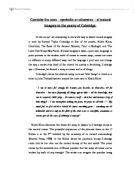She spends many years of her life closed in her house, without having the willingness to have any type of relation with anyone. According to Manley, this withdraw is especially noticeable after the “psychic catastrophe” that she experiences around the year of 1861, when instead of “out of her mind”, she is driven “into her poetry”. He explains how in 1861-2, she agitatedly produces more than 365 poems, all of which “well-wrought” and dexterous. This trauma is caused by the severe suffer from losses of her close relatives, as well as the conditions in which she lives (next to the graveyard). It is largely because of these traumatic experiences that she excessively writes poems and represents her momentary state of mind.
The agonizing and dreadful expressions around this period shows that her life history has been the greatest influence for her to write these poems. Actually, through her poems she releases herself from the anxiety and sorrow she feels. At the beginning of 1861, there exists some hope that she will surpass this period; and at the same time, she writes the poem “Hope” is the thing with feathers(254). In this poem, she still believes that “[she] ha[s] heard”(9) the hope “in the chillest land”(9) and that it “never stops” (4). At this point, she feels optimism and “sweet[ness]”(5) about the world and herself. The optimistic consciousness causes the lack of dashes in this poem, which is strikingly remarkable. Their over-usage is recurring in her way of writing as a symbol of intensity and uncertainty; and they are omitted now. She metaphorically uses the “bird”(7) and its characteristics like “the feathers”(1) and the “sing[ing]”(3) to create a sense of freedom and pureness in her soul that live inside herself. At one point, they are meant to liberate herself form the tension she feels from her lifelong traumatic experience. However, the reality is much harsher than what it seems. Instead of a continuation of her optimism , the “hope” is buried on the “funeral”. The poem I Felt a Funeral, in my Brain (280), written in 1861 after the poem Hope is the thing with feathers (254), depicts her mental breakdown. This poem's prolonged metaphor of the “funeral”(1) is the representation of her mind's collapse. The “funeral”(1) is associated with the psychic insanity she experiences at that moment. She depicts how her “Sense [is] breaking through”(4) and her “Mind [is] going numb”(8). She totally loses sense - her touch with the rational world. All “mourners”(2) are ready for her breakdown, as they are “treading”(3) inside. With “Mourners”(3) she personifies the agonizing events that live in her brain and wait for the final destruction. The time comes, and while saying “finished knowing – then” it is clear that she means about her loss of saneness. The break of mind visible in her poems is reflection of the “seasonal changes in mood” or the bipolar disease, identified by McDermott. All the poems that she writes in the latter period are with this theme of despair and change in mood. Consequently, after the “funeral”(1), the more “formal feeling comes”(1). This “formal feeling”(1) is part of the poem After great pain, a formal feeling comes (341) and it is a feeling of deadness. Her “nerves”(2) are “sit[ting] […] like Tombs”, with mortality and quietness without having sense of time. Her body “mechanical[ly] go[es] round”(5) meaning that it is not important where does she go because everything is pointless now. She mentions that there are people who “outlived” (11) or survived this period. Unlike them, she “freezing[ly]” waits for the death, without any expectation to raise up again. That is implicitly mentioned in the last line of After great pain, a formal feeling comes (341), when she says that she “let[s] [...] [it] go”. This sentence is the fundamental for her condition. It explains that “first” it is “chill”(13), as in the “chillest land”(9) in the poem “Hope” is the thing with feathers(254); then, it is “stupor”, as the unconscious state in which she is in I Felt a Funeral, in my Brain (280); and at the end comes the “letting go”(13) in After great pain, a formal feeling comes (341).
The preoccupation with themes like death and mortality is consequence of the horrifying and traumatic experiences of watching newborn babies and the closest relatives being buried next to her house. These events, except for creating a lunatic and psychopath from herself, are the reason for her astonishing and vanguard way of writing.
If only after these events Emily Dickinson has the ability to write 365 poems in one year, does that mean that in order for a poet to be avant-garde and peculiar as her, he should either be insane or traumatized throughout his life? This is the fundamental question that goes along with the biography of poets like herself. Edgard Allen Poe's manic-depressive disorder, Sylvia Plath's bipolar depression, and Walt Whitman's bipolar disorder are further evidence of how these authors' biographical background leads them to vanguard and peculiar way of writing.
After recognizing that between the poet and his bibliography there exists an inseparable connection, prior to reading any type of poetry, I was focusing on the life history of the poet. The difference was remarkable. At that point, I knew that even Emily Dickinson's poetry will convert from dangerous shark into a feasible fish.
Works Cited:
Bloom, Harold. "Emily Dickinson." Google Books. Web.
<>.
Dickinson, Emily. "Hope” Is the Thing with Feathers(254)
Dickinson, Emily. I Felt a Funeral, in my Brain (280)
Dickinson, Emily. After great pain, a formal feeling comes (341)
Manley, Francis. "On 341 ("After Great Pain, a Formal Feeling Comes--")." Web. <>
McDermott, John F. "Emily Dickinson Revisited: A Study of Periodicity in Her Work." Am J Psychiatry. Web.








